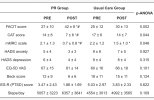Hybrid Pulmonary Rehabilitation Improves Cardiorespiratory Exercise Fitness in Formerly Hospitalised Long COVID Patients
Nikolaos Chynkiamis, Angelos Vontetsianos, Christina Anagnostopoulou, Christiana Lekka, Maria Ioanna Gounaridi, Evangelos Oikonomou, Manolis Vavuranakis, Nikoleta Rovina, Petros Bakakos, Nikolaos Koulouris, Georgios Kaltsakas, Ioannis Vogiatzis
[Line breaks added]
Background/Objectives
Supervised pulmonary rehabilitation (PR) is effective in improving cardiorespiratory fitness in non-hospitalised individuals with long COVID. However, there is limited evidence regarding PR-induced improvements in cardiorespiratory parameters in previously hospitalised COVID-19 survivors.
This study aimed to investigate the effect of a hybrid PR programme (outpatient followed by a digital intervention) on exercise tolerance, cardiorespiratory adaptations, functional capacity and quality of life outcomes in previously hospitalised COVID-19 survivors.
Methods
Forty-two patients (age (mean ± SD): 57 ± 12 yrs) with excessive fatigue due to long COVID (FACIT score (26 ± 10) were allocated to PR (n = 27) or usual care (UC) (n = 15) 140 ± 75 days from hospital discharge.
PR consisted of 8 outpatient sessions (twice weekly for 4 weeks) followed by 24 home-based sessions (3 times/week for 8 weeks). Patients in the UC group were instructed to be physically active. Exercise tolerance was assessed by cardiopulmonary cycling testing to the limit of tolerance.
Results
Following the completion of the hybrid PR programme, peak work rate (WRpeak) and peak oxygen uptake (VO2peak) were, respectively, improved in the PR group by 19 ± 10 Watt (p = 0.001) and by 2.4 ± 3.0 mL/kg/min (p = 0.001).
Furthermore, in the PR group, the 6 min walk distance was increased by 72 ± 69 metres (p = 0.001). FACIT and mMRC scores were also improved in the PR group by 15 ± 10 (p = 0.001) and by 1.4 ± 1.0 (p = 0.001), respectively.
In the UC group, only the mMRC score was improved by 0.7 ± 1.0 (p = 0.008).
Conclusions
The application of a hybrid PR programme was beneficial in improving cardiorespiratory exercise fitness, functional capacity and quality of life in previously hospitalised COVID-19 survivors.
Link | PDF (Journal of Clinical Medicine) [Open Access]
Nikolaos Chynkiamis, Angelos Vontetsianos, Christina Anagnostopoulou, Christiana Lekka, Maria Ioanna Gounaridi, Evangelos Oikonomou, Manolis Vavuranakis, Nikoleta Rovina, Petros Bakakos, Nikolaos Koulouris, Georgios Kaltsakas, Ioannis Vogiatzis
[Line breaks added]
Background/Objectives
Supervised pulmonary rehabilitation (PR) is effective in improving cardiorespiratory fitness in non-hospitalised individuals with long COVID. However, there is limited evidence regarding PR-induced improvements in cardiorespiratory parameters in previously hospitalised COVID-19 survivors.
This study aimed to investigate the effect of a hybrid PR programme (outpatient followed by a digital intervention) on exercise tolerance, cardiorespiratory adaptations, functional capacity and quality of life outcomes in previously hospitalised COVID-19 survivors.
Methods
Forty-two patients (age (mean ± SD): 57 ± 12 yrs) with excessive fatigue due to long COVID (FACIT score (26 ± 10) were allocated to PR (n = 27) or usual care (UC) (n = 15) 140 ± 75 days from hospital discharge.
PR consisted of 8 outpatient sessions (twice weekly for 4 weeks) followed by 24 home-based sessions (3 times/week for 8 weeks). Patients in the UC group were instructed to be physically active. Exercise tolerance was assessed by cardiopulmonary cycling testing to the limit of tolerance.
Results
Following the completion of the hybrid PR programme, peak work rate (WRpeak) and peak oxygen uptake (VO2peak) were, respectively, improved in the PR group by 19 ± 10 Watt (p = 0.001) and by 2.4 ± 3.0 mL/kg/min (p = 0.001).
Furthermore, in the PR group, the 6 min walk distance was increased by 72 ± 69 metres (p = 0.001). FACIT and mMRC scores were also improved in the PR group by 15 ± 10 (p = 0.001) and by 1.4 ± 1.0 (p = 0.001), respectively.
In the UC group, only the mMRC score was improved by 0.7 ± 1.0 (p = 0.008).
Conclusions
The application of a hybrid PR programme was beneficial in improving cardiorespiratory exercise fitness, functional capacity and quality of life in previously hospitalised COVID-19 survivors.
Link | PDF (Journal of Clinical Medicine) [Open Access]

